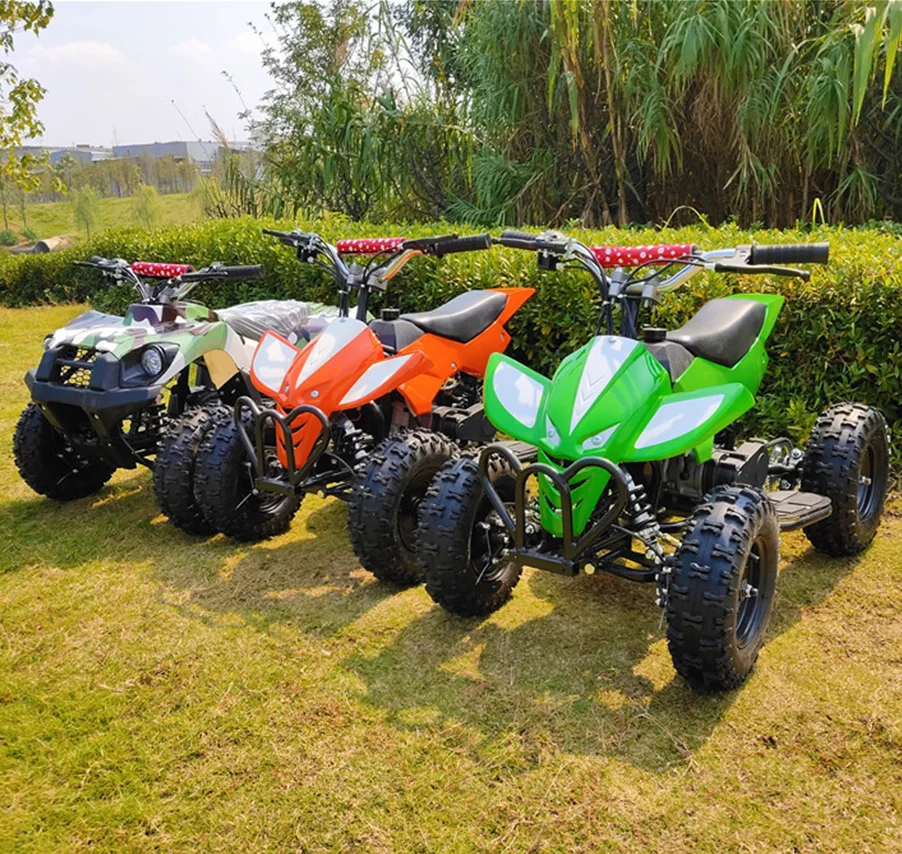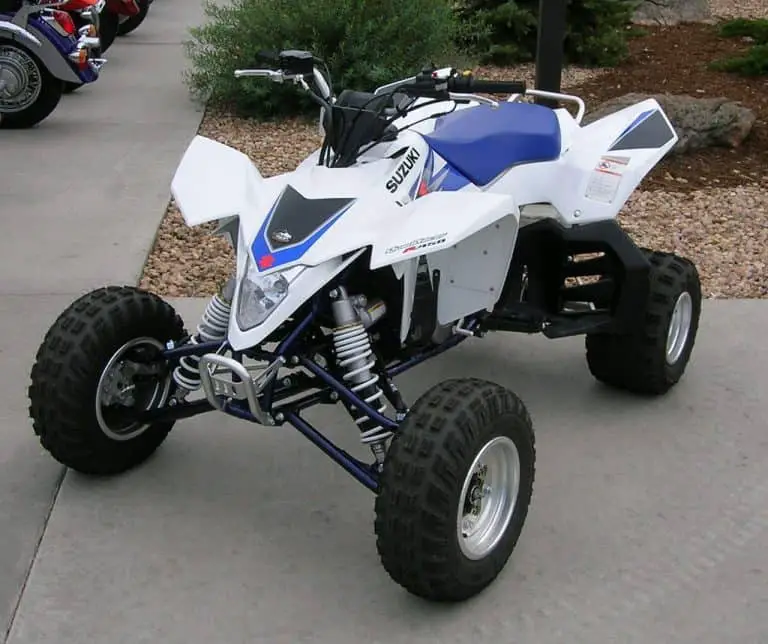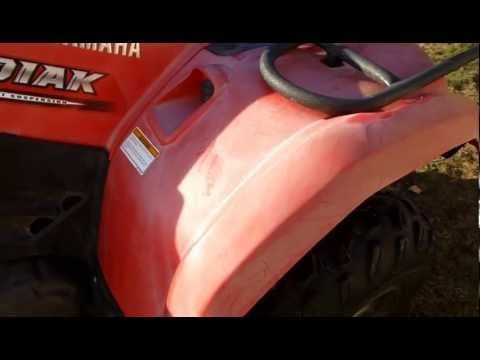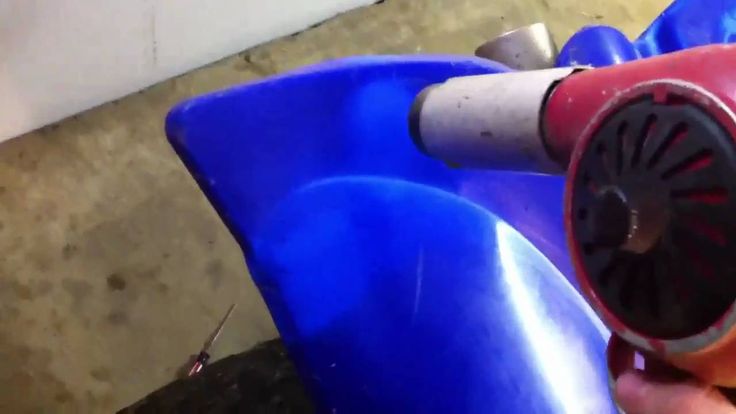Your ATV is a beast of the outdoors, seldom spending much of its life inside. The plastic body of ATVs becomes faded from the sun’s rays, and thrashing around in dirt, mud, snow, and water doesn’t help. Plastics get scuffed by boots or passing debris, and cracks can appear in the body or windshield.
There are a few options for restoring your ATV’s faded plastic so it looks like a showroom model again. These options vary in cost and difficulty. In this guide, we’ll look at all the common ways to restore the luster of your ATV’s plastic body.
Image from www.can-amtalk.com
Linseed oil can restore faded plastic, but it takes ages to dry. You want boiled linseed oil, instead. Note—this doesn’t mean you boil the linseed oil yourself! It means that the linseed oil has been pre-treated to dry faster.
To speed things along, choose boiled linseed oil and mix it with paint thinner. We recommend a 40/60 ratio of linseed oil and paint thinner.
Start by cleaning your ATV thoroughly. For best results, you’ll want to remove the rack and any other parts of the machine that are covering the plastics.
Apply the mixture to your plastics using a dry cloth. You’ll notice the linseed oil will remove the oxidization that’s causing fading. After you’ve applied the mixture to all the plastic, allow it a full day to dry.
If you keep your ATV covered and don’t use it every day, this fix will last for a few months. If you constantly use your ATV outdoors, this treatment may be required to be performed again in 4-6 weeks.
Off-road are the core piece of riding gear for ATV & UTV riders
Find out the best look for you
You’ll need good access to your ATV’s plastics, so remove the skid plates and racks. If they are severely damaged in any way, you may want to replace them completely. To complement your better-looking new plastics, you may want to strip or sand your racks and paint them with a spray-on bedliner.
Next up, give the ATV a good clean overall. A mixture of dishwashing liquid and water will remove all the grease and oils from the surfaces.
Now it’s time to prepare the plastic for waxing. This means sanding the plastic with fine sandpaper, working your way up from the lowest number of sandpaper up to the highest. You can use an oscillating tool to speed up the process. Make sure you’re wearing safe gloves, and finish up by sanding with steel wool.
Apply a vinyl floor liquid wax to the plastic using a car wax applicator. Using thin coats, you can work on one section of the plastic while another section dries. You will need to apply several coats, buffing out the plastic after each application.
After the final coat is complete and bone dry, finish up with an automotive wax for an extra layer of sheen.
This process is more involved than the linseed oil and paint thinner fix, but it typically has a longer-lasting result.
Image from www. atvhonda.com
atvhonda.com
Instead of a linseed oil and paint thinner mixture or vinyl liquid wax, you can use a dedicated plastic restorer product. While most of these products work very well, they are basically just variations of our above options with slightly different chemical compositions.
Image from Lea Arnold YouTube channel
Using a heat gun does work to make plastics look new, but it has downsides.
To perform the procedure, you use a heat gun set to a low setting and blow it from a few inches above the problem plastic. Voila—the plastic looks as good as new.
But it’s not really an option that we recommend. It works by melting the top layer of the plastic, which in turn makes the plastic more brittle. Every time you perform a heat gun restoration, your plastics lose some strength.
Where we would suggest using a heat gun is to work out small cracks in the plastic. Severe cracks necessitate replacement, though.
These are the top ways to restore your ATV plastic. Another option is to cover your faded plastic with a new lick of paint from a spray paint that’s specifically suitable for plastic. Whatever option you choose, with just a little bit of elbow grease you can have your ATV back in showroom condition.
SPORTSMAN
36 EUR
32.40 EUR
ENDURO
the most durable
577 EUR
AQUAMASTER-ZIP LIGHT
with central zipper
568 EUR
ENDURO LIGHT
the most durable
378 EUR
AQUAMASTER LIGHT
reliability & comfort
438 EUR
NEODRY
16 EUR
12.80 EUR
-10%
HIT
ENDURO
the most durable
229 EUR
206. 10 EUR
10 EUR
AQUAMASTER
reliability & comfort
567 EUR
-30%
HIT
AQUAMASTER
reliability & comfort
259 EUR
181.30 EUR
BELT
8 EUR
7.20 EUR
ENDURO BF
bootfoot waders
468 EUR
ENDURO BF
bootfoot waders
289 EUR
260.10 EUR
ENDURO
29 EUR
26.10 EUR
NEOSENSOR
14 EUR
9.80 EUR
MUDWAY
179 EUR
TARGET 20L
32 EUR
22.40 EUR
MUDRIDER
299 EUR
209.30 EUR
-10%
HIT
WADEMAN
lightweight waders
159 EUR
143. 10 EUR
10 EUR
-10%
HIT
MUDWAY NEW
199 EUR
179.10 EUR
URBAN
79 EUR
71.10 EUR
Explore all
Since ATVs invest the majority of their time outdoors, their plastic body ends up being discolored from the sunlight's rays, as well as surging around in dirt, mud, snow, and also water does not help. Plastics get messed up by boots or passing particles, and also splits can appear in the body or windshield.
There are a few choices for restoring your ATV's faded plastic so it appears like a showroom model once more. These alternatives differ in price as well as problem.
In this guide, we clarify exactly how to make your ATV resemble new. We provide you with some suggestions on exactly how to restore ATV plastic.
Table of Contents
Now that you understand what creates your ATV plastic to fade allow's take a look at the various ways you can recover your vehicle to its previous glory.
When it concerns restoring your ATV, there are many methods that can be made use of to take on discolored plastic, with everyone delivering different outcomes. So to help you at the same time, we have actually detailed the various techniques down below.
Before you restore your ATV plastic, you should keep your ATV clear. Wash the ATV completely using Dawn dishwashing fluid. Dawn helps get rid of oils and grease from the surface area. And afterward, completely dry the maker totally. If there are scratches, you will also require to sand its plastic surface.
Linseed oil can recover discolored plastic, however, it takes ages to dry. You need boiled linseed oil, rather. Note-- this does not imply you steam the linseed oil on your own! It implies that the linseed oil has actually been pre-treated to completely dry faster.
To speed up points along, choose boiled linseed oil and mix it with paint thinner. We advise a 40/60 proportion of linseed oil as well as paint thinner.
We advise a 40/60 proportion of linseed oil as well as paint thinner.
Begin by cleaning your ATV extensively. For best results, you'll intend to eliminate the rack as well as any other parts of the device that are covering the plastics.
Apply the mix to your plastics using a completely dry cloth. You'll discover the linseed oil will remove the oxidization that's causing fading. After you have actually used the blend to all the plastic, allow it a full day to dry.
If you maintain your ATV covered and do not use it on a daily basis, this restore will certainly last for a couple of months. If you continuously use your ATV outdoors, this treatment might be called for to be done again in 4-6 weeks.
The following video shows you how to restore ATV plastic with boiled linseed oil.
There are plenty of products in stores that declare to recover plastic. One of the most preferred is Solution Finish and CAR GUYS Plastic Restorer.
One of the most preferred is Solution Finish and CAR GUYS Plastic Restorer.
A look through customer testimonials shows that they work. How much time the remediation lasts differs from item to item, and just how well you protect your ATV. Yet most appear to last for a number of months.
When using a certain restorer, inspect the instructions of the application on the label. Also, the majority of these items are likewise helpful for plastic. If your ATV seat has a plastic cover, you can make use of these restorers to reverse fading.
First, you should remove the skid plates and racks. If they are drastically damaged whatsoever, you might intend to replace them totally. To enhance your better-looking new plastics, you may intend to strip or sand your racks and repaint them with a spray-on bed liner.
Next up, offer the ATV a good clean overall. Now, it's time to prepare the plastic for waxing. This means fining sand the plastic with fine sandpaper, working your way up from the lowest amount of sandpaper to the highest. You can also use an oscillating device to quicken the process. Make certain you're wearing risk-free gloves, and finish up by fining sand with steel wool.
This means fining sand the plastic with fine sandpaper, working your way up from the lowest amount of sandpaper to the highest. You can also use an oscillating device to quicken the process. Make certain you're wearing risk-free gloves, and finish up by fining sand with steel wool.
Use a vinyl flooring liquid wax to the plastic using a car and truck wax applicator. Using thin layers, you can service one area of the plastic while one more section dries. You will need to apply a number of coats, and polish the plastic after each application.
After the last layer is full and also bone dry, end up with an automotive wax for an added layer of luster.
This process is more complex than linseed oil and paints thinner restoration, but it usually has longer-lasting results.
This is the debatable one that we don't advise. It works such as this: you set the heat gun to the lowest setting and blow it a few inches away from the plastic, moving slowly over the discolored areas.
This approach generates instant outcomes. The faded plastic instantly appears new and also glossy.
While it functions, how it works is the issue. The heat partially thaws the top layer of the plastic, making it show up new.
Comparable to various other plastic restore methods, the heat gun method does not last forever. Oxidation as well as fading will certainly return after a number of weeks or months. So you need to duplicate the treatment.
The trouble is that every time you use a heat gun, the plastic gets more brittle as well as more probable to crack as you set about your riding.
So we do not suggest making use of a heat gun. Use linseed oil or a plastic restorer. If you want long-term remediation, see the last method below. You can watch the following video to learn how to restore ATV plastic with the heat gun.
 Paint
PaintFor the last approach, we are going to go over; we have selected an option that is arguably one of the most efficient when it comes to restoring ATV plastic. If you see that your ATV has actually begun to discolor, you can constantly battle the issue by repainting it.
You can do this by using spray paints ideal for ATV plastic, although you will need to apply a primer coat and a safety top layer for the best outcomes.
Like the majority of recovering approaches, paint is not permanent as well as will certainly start to fade with time. Nevertheless, it can last much longer than various other repair choices and can be quickly reapplied whenever the plastic begins to discolor.
If you want to learn more about paint, you can click here to get a guide for painting your ATV step-by-step.
Broken plastic is a little bit a lot more challenging to fix. If a piece of the plastic has come off, not simply a basic fracture, you may be much better off changing the whole plastic part.
However, if it's just a crack, there's hope. We discovered numerous feasible means to repair broken ATV plastic. Nonetheless, most of them, such as using epoxy or superglue do not work well. As quickly as you go out with the ATV once again, the sealed cracks are then loosened
The solution that appears to work ideal is melting the plastic. You can use a plastic welder, heat gun, soldering iron, or some other source of heat to melt the plastic along the crack. You'll require to apply stress on both sides of the plastic up until the melted plastic remedies and holds.
For larger fractures, you may need to thaw an exterior plastic to fill the fracture. You can also get plastic welding rods or reinforcement plastic mesh.
When it comes to the windshield, because it is likely acrylic, an acrylic solvent concrete or an acrylic adhesive is the best option.
Adhere to the directions on the label. Keep in mind to clean the windshield before using any item.
Plastic burs very easy as well as wet fining sand will prevent that. With the 180 grit just sand the actually bad areas as well as get the deep scratches, nothing even more. After they have gone away, Use 220 on the overall vehicle. Sand up until the shade is also all over and the scratches are gone.
Brightening with Toothpaste or Sodium Bicarbonate Toothpaste and baking soda are both light abrasives that you can make use of to brighten plastic. For deeply etched or blemished plastic, capture non-gel toothpaste straight onto the surface and also buff it in a circular movement with a microfiber or cotton cloth.
WD-40 Multi-use product is excellent for most plastic surfaces that have actually had a great deal of exterior direct exposure, so it's great for garden furniture. It is very important to note that Polycarbonate and clear polystyrene plastics are among the very few surfaces where WD-40 multi-purpose products can be avoided.
It is very important to note that Polycarbonate and clear polystyrene plastics are among the very few surfaces where WD-40 multi-purpose products can be avoided.
The very best method I have actually located for removing light scrapes is to choose some 1500 Grit Wet Sandpaper. Just utilize the sandpaper over the locations with scrapes and also enthusiast it out when you're done. You can end up with a coat of the plastic restorer I discussed above to make it look new.
To restore the shine, apply a small amount of plastic or metal polish just enough to cover the dull areas, then apply it in a circular motion with a clean, dry cloth. You may need to repeat the process a few times, but eventually, the plastic will shine like new again.
The Most Comprehensive Motorcycle Camping Gear Checklist (Ultimate guide for you)
Rodney L Herron
Rodney L is a technical writer and product consultant with over a decade of experience in the motor industry. Rodney is a fan of performance machines that run fast and loud and an expert in all things custom. His numerous articles and write-ups are available at our knowledge base. Whether it’s something wrong with your motorcycle or you are building a custom bike, you can trust Rodney’s experience.
Rodney is a fan of performance machines that run fast and loud and an expert in all things custom. His numerous articles and write-ups are available at our knowledge base. Whether it’s something wrong with your motorcycle or you are building a custom bike, you can trust Rodney’s experience.
Plastic polishing on ATVs
We know from advertising: “if your TV screen has lost its former brightness, just wipe the dust off the screen.” Something similar can be done with the details of the ATV.
If the plastic lining of your ATV has a lot of small scratches (this method is not suitable for deep scratches) and began to look unpresentable, do not rush to run to the store, you can try to polish it. This process is long, tedious and painstaking, if done correctly, the place of cloudy abrasions will be taken by an even gloss. Similar technologies are used to remove scratches from mobile phones and laptops, polishing car headlights. The plastic of the vast majority of ATVs acquires its color already at the stage of its production, and not during painting, thus it is an ideal candidate for "resurrection".
Before starting work, the plastic element must be degreased and removed as much as possible from stickers and fasteners. It is important to maintain cleanliness during all stages of restoration and to prevent dirt from entering the restored area.
Estimate the depth and nature of the scratches by eye, you will need this when choosing the appropriate sanding paper (the deeper the scratches, the “angrier” the sanding paper should be).
The sanding process takes place in several iterations with a gradual change in the grain size of the sandpaper according to the principle from larger to smaller. For the best effect, water the "sandpaper" and plastic with water. The last few approaches are performed with a gentle "zero". The surface of the plastic will become smooth, but still cloudy.
This is where polish comes into play. A specialized polish for motorcycles on the domestic market cannot be found in the afternoon with fire. The loss is not great - automobile and other analogues are no worse and much cheaper. Apply polish to a soft non-abrasive rag, sponge, napkin or piece of felt (all this can be found in an ordinary car shop), rub the substance over the surface of the plastic in a circular motion with light pressure. After 10-15 minutes (the polish should dry and absorb), apply another layer. The procedure must be repeated until an even gloss appears on the entire surface of the part.
The loss is not great - automobile and other analogues are no worse and much cheaper. Apply polish to a soft non-abrasive rag, sponge, napkin or piece of felt (all this can be found in an ordinary car shop), rub the substance over the surface of the plastic in a circular motion with light pressure. After 10-15 minutes (the polish should dry and absorb), apply another layer. The procedure must be repeated until an even gloss appears on the entire surface of the part.
Sanding and polishing can be done both manually and with the use of a special tool (polishing machine or nozzle on a drill), this will significantly speed up the execution, but it is important not to overdo it - when overheated, dull areas and bubbles may appear on the surface. At the exit, after 4–5 hours of work, the old and worn ATV linings will acquire an almost pristine factory shine, while your wallet will not be empty for an amount equivalent to the cost of the original part in the salon of an authorized dealer.
Ice Redoubt > 26 February 2013 10:09 Mikhail Pimus
Share:
Many people ask if we repair plastic parts of ATVs, motorcycles, scooters and similar equipment, since they were refused in other stations and workshops, referring to the peculiarity of such plastic.
We refurbish all kinds of plastic surfaces. Your snowmobile, scooter, motorcycle, or boat is made from plastics that are found in cars, appliances, and appliances. There is nothing unusual, “specific” in it, and the use of modern technologies makes it possible to repair / restore any of its varieties.
Quite often we have to deal with the restoration of motorcycle plastic after it has been repaired by other "specialists".
The original plastic used for the manufacture of motorcycles, scooters and other compact equipment is strong enough to withstand drops at low speeds without consequences. With a more serious fall, cracks and breaks cannot be avoided. Therefore, the repair of such plastic consists in restoring the integrity of the product. One of the most important conditions for high-quality repair is the preservation of the structure of the material in the place of the fracture of the body. Therefore, a professional always pays attention to the technological characteristics of a particular plastic (filler properties, boiling / melting points, etc.).
Therefore, the repair of such plastic consists in restoring the integrity of the product. One of the most important conditions for high-quality repair is the preservation of the structure of the material in the place of the fracture of the body. Therefore, a professional always pays attention to the technological characteristics of a particular plastic (filler properties, boiling / melting points, etc.).
Welding motorcycle plastic with a soldering iron, non-compliance with the temperature regime leads to the fact that the weld begins to boil. In this case, the plastic becomes brittle, its elasticity is irretrievably lost, and the weld is inhomogeneous and weak. Reinforcement of plastics is also not allowed, since metals and plastics have incompatible physical characteristics (adhesion, temperature coefficients) and will behave completely differently in the event of an impact load. Such foreign elements in the event of an accident, instead of a crack, give an uneven ragged hole.